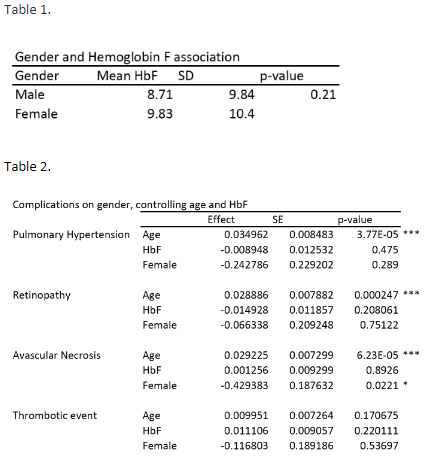Sickle cell disease (SCD) continues to be the most common inherited blood disorder in the United States, characterized by a mutated HBB gene in hemoglobin subunit β (Kato 2018; Sedrak 2023). Currently, hydroxyurea is the gold standard treatment for SCD due to its mechanism of raising fetal hemoglobin (HbF) levels, ultimately lessening pain crises and need for blood transfusions (Acharya 2023). Prior to widespread usage of hydroxyurea, significant differences were found regarding HbF levels between males and females. In many cases, females were found to have, on average, higher HbF levels (El-Hazmi 1994; Ceglie 2019; Solovieff 2010; Sutnick 1968). The aim of this study is to determine whether sex-related differences presently exist in HbF levels in patients with SCD after Hydroxyurea use.
This is a cross-sectional study conducted at the Center for Blood Disorders in Augusta, Georgia, consisting of a total of 496 patients diagnosed with SCD. Variables analyzed from this database included sex (male v. female), levels of HbF, and common complications of SCD: pulmonary hypertension, retinopathy, avascular necrosis, and thrombosis. Levels of HbF were calculated based on percentage and averaged. Two-sided t-test was used to identify differences between male and female HbF levels. Correlation of common complications of SCD with sex was observed using Pearson's coefficient and Fisher's z-test using R version 4.2.3. P value <0.05 was taken as significant. To control for confounding factors, HbF levels and age were included as covariates in the logistic regression when exploring the relationship between sex and complications of SCD.
The 496 SCD patients consist of 233 males and 263 females. The males had a mean HbF of 8.71 (SD 9.84), and the females had a mean HbF of 9.83 (SD 10.4). A two-sided t-test resulted in a p-value of 0.21. 85 patients (45 female) had a history of pulmonary hypertension. The correlation between female sex on likelihood of developing pulmonary hypertension controlling for age and HbF was -0.24 (SE 0.22).121 patients (66 female) had a history of retinopathy. The correlation between female sex and the likelihood of developing pulmonary hypertension controlling for age and HbF retinopathy was -0.0066 (SE 0.21).177 patients (86 female) had a history of avascular necrosis. The correlation between female sex and likelihood of AVN controlling for age and HbF was -0.43 (SE 0.19).131 patients (72 female) had a prior thrombotic event. The correlation between female sex and likelihood of thrombotic event controlling for age and HbF was -0.12 (SE 0.19).
The findings reveal no significant relationship between sex and HbF levels. We posit that this may likely be due to the effect of hydroxyurea treatment for SCD, as prior to treatment, there were significantly higher HbF levels in females (El-Hazmi 1994; Ceglie 2019; Solovieff 2010; Sutnick 1968). Adjusting for age and HbF levels, we found that there were no significant differences between the sexes in terms of risk for developing complications of pulmonary hypertension, sickle cell retinopathy, and thrombotic events. We did find that there was a significant difference between the sexes in terms of risk for developing avascular necrosis, where females were shown to have a decreased risk compared to males. Due to our limitation with sample size, next steps would entail analyzing these relationships with a larger database. With a more extensive data set of patients with SCD, further relationships may be elucidated regarding sex differences in the progression of disease that could aid in informed treatment decisions.
Disclosures
Kutlar:GBT/Pfizer: Honoraria, Membership on an entity's Board of Directors or advisory committees, Research Funding; Novartis: Consultancy, Honoraria, Membership on an entity's Board of Directors or advisory committees, Research Funding; Forma/Novo-Nordisk: Research Funding; Akira Bio: Membership on an entity's Board of Directors or advisory committees, Research Funding.


